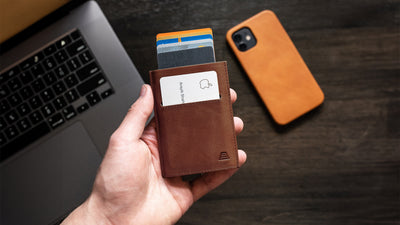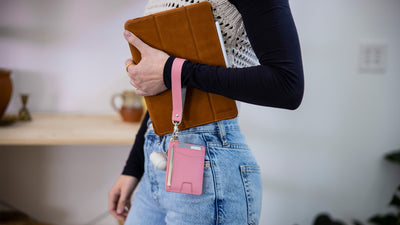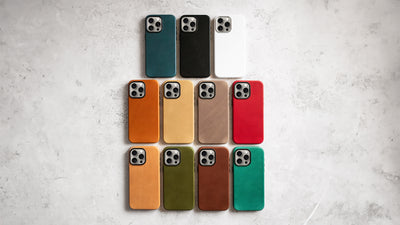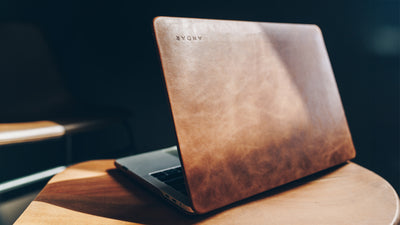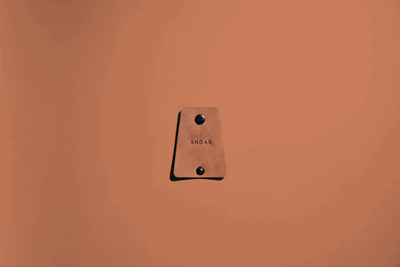The Blog
How to Identify Leather Types

Ever wondered how to identify leather types? At Andar, we specialize in handcrafted full-grain modern leather goods and are here to guide you.
In this article, we'll explore these variations and show you how to distinguish between them. Whether it's the rich character of aniline or the sleek finish of bicast, our expertise will help you navigate the world of leather.
Discover the secrets to identifying quality leather with us!
What this article covers:- Examples of Different Leather Types
- What Is the Difference Between Different Types of Leather?
- How to Tell If Something Is Real Leather
- How to Identify Leather Types FAQs
Examples of Different Leather Types
At Andar, we know that understanding different leather types is essential for choosing the perfect leather product.
Let's look at some examples.
Table: Different Types Of Leather
|
Leather Type |
Characteristics |
|
Waxed Oil Or Pull-Up Leather |
|
|
Semi-Aniline Or Lightly Finished |
|
|
Aniline Or Unfinished Leather |
|
|
Bicast Leather |
|
Waxed Oil Or Pull-Up Leather
Waxed oil or pull-up leather is one of the most robust types, and we're proud to use it in our Andar products. This leather is treated with oil or wax, which gives it a rich, glossy appearance.
What is patina on leather? Over time, this type of leather develops unique characteristics or patterns (known as a ‘patina') over time, making each piece distinct.
After trying out this product, we noticed how applying our specialized leather wax to a full grain leather bag like The Indie gave its overall color an enhanced richness. This is particularly evident with the woodsy aesthetic of The Timber version.
Semi-Aniline Or Lightly Finished Leather
Semi-aniline leather strikes a perfect balance between natural look and durability.
Our findings show that this type of leather retains the natural grain but has a light protective coat that makes it more resistant to stains and fading.
This finish allows it to maintain a smooth contour while offering some level of protection against wear and tear.
Aniline Or Unfinished Leather
Aniline leather is one of the most natural and luxurious types, often regarded as a pure form of leather.
Based on our first-hand experience, aniline leather is treated with soluble dyes that don't cover the surface with a topcoat or pigment, leaving the natural texture and markings visible.
This type of leather is highly susceptible to stains and requires careful maintenance while offering a measure of softness and comfort.
Bicast Leather
Bicast leather is a composite material made by bonding a layer of polyurethane to a split leather backing. This fusion creates a product with a consistent appearance and a glossy finish.
While it offers a cost-effective option for achieving a leather-like look with added strength, bicast isn't as breathable or natural as other natural leather types that we offer here at Andar.
What Is the Difference Between Different Types of Leather?
The key differences between various kinds of leather comes down to flexibility, odor, and grain pattern.
Flexibility
Flexibility in leather varies significantly depending on the type.
For instance, full-grain leather, known for its strength and thickness, is less flexible but more robust. In contrast, top-grain leather has a slightly more pliable texture due to surface sanding, but doesn't last as long as full-grain leather.
As indicated by our tests, an Andar product made from full-grain leather like The Manhattan effectively maintains its shape and offers superior resistance to wear. This makes it ideal for carrying items like your electronic devices and leather wallets that need to withstand daily use.
Odor
The smell of leather is a key indicator of its type and quality.
Through our practical knowledge, full-grain and top-grain leather in particular have rich, natural scents that are considered appealing and authentic.
Conversely, lower-grade leathers like bonded leather might have a more artificial smell due to the processing chemicals used during manufacturing.
At Andar, we ensure that our full-grain leather bags and leather cases retain their natural aroma, enhancing the user experience with every use.
This authentic scent is a hallmark of the premium materials we use, setting our products apart from synthetic or heavy chemically processed leathers.
Grain Pattern
Grain pattern is another distinguishing feature among different types of leather.
For example, full-grain leather showcases the natural grain of the hide, including imperfections and unique markings, which adds to its character and uniqueness. Top-grain leather, while slightly modified through sanding and buffing, still retains a smooth and consistent aesthetic.
Our investigation demonstrated that the natural grain patterns in our full-grain leather products enhance their aesthetic appeal, making each piece one-of-a-kind.
How to Tell If Something Is Real Leather
At Andar, we have several tips to show you how to tell if leather is real or not.
1. Check The Label
One of the simplest ways to determine if a product is made of real leather is by checking the label. In this context, you might be wondering, ‘What is the best leather?' We use the highest leather standard, which is full-grain leather, and label our authentic leather products proudly and transparently as such.
2. Examine The Appearance
What is genuine leather or real leather? As per our expertise, real leather has a distinctive look containing natural perfections which synthetic materials can't perfectly replicate.
This often takes the shape of wrinkles, scars, or variations in color, which add to real leather's unique beauty.
We've found from using our wallets and leather iPhone cases that The Turner and The Aspen in particular are extremely lightweight and durable. They adapt seamlessly to the contents they hold, becoming more personalized with each use.
3. Feel The Material
The feel of the material is another key indicator of real leather. Authentic leather is soft and warm to the touch, as well as somewhat adaptable, whereas fake leather often has a plastic contour.
After putting it to the test, we found that a Macbook Air case like The Helm showcases this premium appearance of genuine leather that our customers love.
For instance, KA, one of our verified buyers, said: "I love the color and it feels like good quality!" while YM, another one of our loyal customers, praised The Helm's "great look and feel".
4. Smell The Material
Real leather has a distinct, rich, and earthy smell, unlike the chemical or plastic scent of synthetic leather.
Our analysis of an Apple Watch band like The Watch Band revealed that our customers like LE have praised it for its natural aroma by saying that "the leather smells good”.
At Andar, this is a testament to the high standard of the full-grain leather we use in all our products.
How to Identify Leather Types FAQs
What Is Considered Fake Leather?
Fake leather, also known as synthetic leather, is made from plastic-based materials like polyurethane (PU) or polyvinyl chloride (PVC).
Unlike real leather, which comes from animal hides, fake leather is manufactured to mimic the look and appearance of real leather without the same resilience or aging characteristics.
Our research at Andar indicates that identifying fake leather involves looking for uniform grain patterns and a plastic-like texture, as these are common traits of synthetic materials.
Is Patent Leather Real Leather?
Patent leather is indeed real leather, but it's coated with a high-gloss finish that gives it its distinctive shiny features.
Drawing from our experience, this leather is typically treated with a lacquer or plastic coating, making it more resistant to water and stains but is less breathable than untreated leather.
While it's still considered as real leather, patent leather doesn't offer the same natural aging process as full-grain leather, for instance, due to its coated surface.
Does Real Leather Peel?
Real leather shouldn't peel under normal circumstances.
Peeling often indicates that the leather is:
- of low quality
- bonded with another material
- a synthetic leather
Genuine leather may develop a patina and show signs of wear, but it won't peel like synthetic materials.
Based on our first-hand experience, premium full-grain leather products consistently retain their integrity and don't peel, even after extended use.
Can You Scratch Real Leather?
Real leather can be scratched, as it's a natural material. While these scratches can sometimes add character to the leather and contribute to its unique patina, deeper scratches can be unsightly though.
We determined through our tests that minor scratches can often be buffed out or treated with our leather cleaner and conditioner in The Leather Care Kit to minimize their appearance.

Conclusion
In this article, we explored how to identify leather types by discussing various leather examples and highlighting ways to tell the difference between various leather types.
Understanding these differences is essential for choosing the right product for your needs. Our full-grain leather products offer the best in quality and durability. This makes them a smart investment for anyone who values handcrafted, fashion-forward accessories.
So, what are you waiting for?
From our full grain leather handbags to our leather phone cases, experience the superior craftsmanship and elegance first-hand that we bring to every piece here at Andar now!
If you want to learn more, why not check out these articles below:
- How to Identify Full Grain Leather
- What Is Vegan Leather
- Where Does Leather Come From
- What Is Top Grain Leather
- What Is Eco Leather
- Best Vegan Leather Bags
- Best Leather Backpack Purse
- Best Men's Leather Work Bag
- Best Mens Leather Weekend Bag
- Best Leather Fanny Pack
- Best Leather Shoulder Bags
- Best Black Leather Bags
- Which Leather Is Best for Bags?
- Best Leather Backpacks for Women
- Best Mens Leather Backpacks
